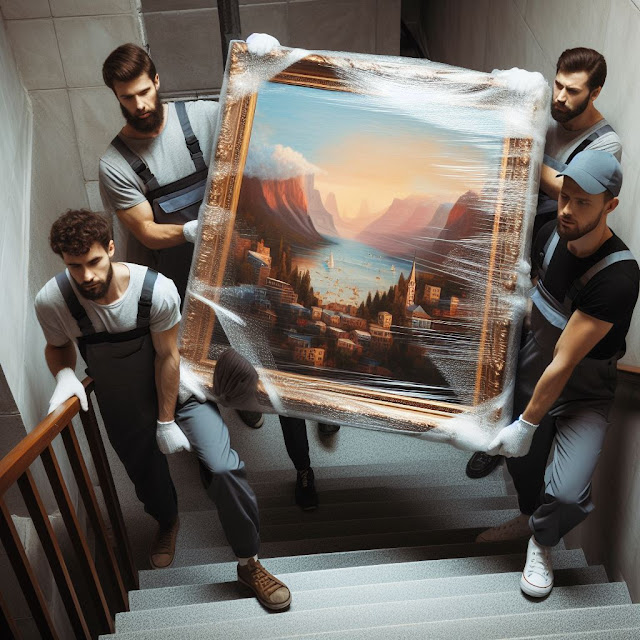Art Movers
We specialize in delicately transporting priceless art pieces. Our meticulous handling ensures a seamless, secure relocation of your art work.
Introduction
Relocating or transporting fine art requires more than just movers -- it requires artisans of precision, guardians of delicate strokes, and skilled craftsmen. Culture legacies and emotional narratives are entrusted to art movers, which act as custodians of creativity. It's a dance that safeguards beauty, preserves history, and ensures the brushstrokes are unharmed.
Specialized Services Offered
Art movers are indispensable when transporting delicate and valuable art pieces. Artwork professionals offer specialized handling, packing, and transport services tailored to the specific needs of various forms, sizes, and fragilities of artwork. Moving art pieces is a crucial part of preserving them as well as relocating them safely. From paintings to sculptures to intricate installations, art movers play a crucial role in the process.
Customized Packaging: Customized packaging solutions are created by art movers for each piece of artwork. To safeguard against any potential damage during transportation, they carefully evaluate the dimensions, medium, and fragility of the piece. As part of this process, custom crates, foam padding, and climate-controlled containers may be used to ensure artwork's safety.
Climate-Controlled Transport:Artwork must be kept in the right environment in order to be preserved. Temperature, humidity, and light exposure during transit are controlled by climate-controlled art movers. Temperature and humidity fluctuations can cause damage to sensitive artworks, which can be mitigated in controlled environments.
Expert Handling and Installation: In order to handle various types of art pieces carefully, art movers are trained in the art. For moving, lifting, and positioning artworks safely, they use specialized techniques and equipment. As part of this process, pieces are installed in their new location, ensuring they are securely positioned as instructed by the artist or curator.
Risk Assessment and Insurance: Prior to transportation, art movers identify potential hazards and implement measures to mitigate them. As well as offering comprehensive insurance coverage, they often take care of ensuring that the artworks being transported meet the needs and expectations of the insurance company. The policy provides financial protection in the event of an unforeseen loss or damage.
International Logistics:International art movers handle complex logistics, such as customs regulations, import and export requirements, and necessary documentation, for artworks traveling across borders. As a result, the artwork is transported smoothly and compliantly.
Consultation and Advisory Services:Art movers often offer more than just physical transportation. Through their expertise, they provide advice to collectors, galleries, and museums on how to care for, store, and transport artworks.
Ensuring preservation and safety of artworks
In order to preserve and safeguard artworks, meticulous care, advanced technology, and profound appreciation for cultural heritage are required. In addition to protecting these valuable treasures, we should maintain their integrity, beauty, and historical significance for future generations to enjoy and learn from.
Diverse mediums and eras of art are intrinsically vulnerable to environmental factors, human handling, and time. For this reason, preserving them requires multifaceted approaches that encompass a variety of factors:
Conservation Techniques: To understand artworks' materials, techniques, and conditions, conservationists use scientific methodologies. In order to maintain authenticity, they employ methods such as cleaning, stabilizing, and restoring while adhering to ethical guidelines.
Climate Control: A work of art can be affected by fluctuations in temperature, humidity, light exposure, and pollutants. Environmental factors such as temperature, humidity, and air pollution are carefully controlled by museums and galleries to prevent deterioration. It is important to maintain optimal conditions for storage and display in climate-controlled spaces.
Advanced Technology:Technology innovations, like high-resolution imaging, 3D scanning, and spectroscopy, assist in analyzing, documenting, and restoring artwork without harming it.
Security Measures: The protection of artworks against theft and vandalism is paramount. A museum's or collector's safety is ensured by access control, surveillance, and specialized transportation methods.
Provenance and Documentation: Artwork histories, ownerships, and conservation treatments must be meticulously documented. It contributes greatly to its preservation and value to trace its provenance and authenticity.
Education and Awareness: A sense of responsibility and respect for cultural heritage is fostered when the public is made aware of the importance of art preservation. Communities are engaged in understanding and safeguarding these treasures through educational programs, exhibitions, and outreach initiatives.
Collaboration and Research: Knowledge exchange and advancements in preservation techniques are made possible by collaboration among institutions, conservationists, scientists, and artists. The development of innovative methods for conserving artworks is aided by ongoing research.
In order to preserve and safeguard artworks, dedication, expertise, and resources are needed. We can safeguard these invaluable creations for future generations by combining tradition and technology and fostering a collective awareness of the importance of our artistic heritage. The timeless legacy of art can only be preserved through our efforts today.
Specialized training for handling delicate art pieces
Performing safe transportation and handling of delicate and valuable artwork is the responsibility of art movers. For the preservation and safe delivery of these priceless pieces, specialized training and expertise are required. Professionals in this field need the following training:Understanding Art Materials and Fragility
The foundation of specialized training involves understanding the fragility and behavior of various art materials. Each piece needs a specific handling method and precautions, which this knowledge allows movers to determine.
Packing Techniques and Materials
A professional art mover undergoes extensive training in packing techniques and specialized materials. A secure packaging method, custom crates, and cushioning materials are crucial to safeguarding artworks in transit.
Handling Protocols and Equipment Usage
It is essential to use specialized equipment and protocols when handling delicate art pieces. Cranes, dollies, and climate-controlled trucks, as well as proper lifting techniques, maneuvers, and handling equipment are all included in training.
Risk Assessment and Mitigation
During transit, professionals assess potential risks and devise strategies to mitigate them. In order to accomplish this, it is necessary to understand environmental factors, transportation challenges, and possible hazards that may compromise the safety of the artwork.
Climate Control and Environmental Considerations
In order to preserve artworks, it is crucial to maintain the right climate conditions. During the training, participants learn how to manage temperature, humidity, and light exposure during transportation and storage.
Communication and Coordination
It is imperative that team members and clients communicate effectively and coordinate their efforts. To ensure a smooth and secure handling process, training emphasizes clear communication protocols, teamwork, and coordination.
Documentation and Record-Keeping
A key aspect of art moving is meticulous documentation. Documenting the condition of artworks before, during, and after transportation is done by professionals who are trained in proper record-keeping, cataloging, and traceability.
Emergency Response and Contingency Planning
Emergency response protocols are taught to art movers in the event of unforeseen circumstances. In addition to contingency plans, people should be prepared for accidents and natural disasters by setting up alternative routes, contacting emergency contacts, and following procedures.
Ongoing Professional Development
Keeping up with advancements in handling techniques, materials, and equipment is crucial in the art moving industry. In order to maintain their skills and adapt to changing industry standards, professionals engage in ongoing education and training.
Expansion into global markets
The world of art movers has transcended local landscapes to embrace the global canvas in an age when art knows no boundaries. Art movers are expanding into global markets more than just logistically; they are engaging in cultural exchange, fostering innovation, and developing strategic vision.Art movers have evolved significantly from their traditional roles. It is now possible for these entities to venture into uncharted territories across continents by organizing local exhibitions and transporting artwork within a limited radius. A number of factors are driving this expansion:
Globalization of Art: Art is no longer confined within national borders. A seamless and secure transportation network for artworks across the globe is essential for collectors, galleries, and artists themselves.
Demand for Expertise: Increasingly valuable and delicate artworks demand specialized expertise in handling, packaging, and transportation. By offering expertise and knowledge of international regulations, art movers with a global presence offer assurance.
Technology and Innovation:As a result of the digital age, logistics has undergone a revolution. With cutting-edge technology, art movers manage inventory, control climate, and transport priceless pieces across continents safely.
Cultural Exchange: As a result of global expansion, cultural exchange is fostered beyond logistics. In facilitating exhibitions and collaborations between diverse cultures, art movers act as conduits.
Globalization, however, poses unique challenges:
Regulatory Hurdles: A seamless transit requires meticulous planning and legal expertise to navigate customs regulations, import/export laws, and compliance standards across different countries.
Security Concerns: The security of artwork in transit, which is often irreplaceable and valuable, becomes increasingly important. To protect their artworks from theft, damage, or environmental hazards, art movers must deploy state-of-the-art security measures.
Cultural Sensitivities: The importance of understanding and respecting diverse cultural nuances cannot be overstated. It is important to be sensitive and adaptable when handling and displaying art in different regions.
Logistics and Infrastructure: A region with different infrastructure capacities can pose logistical challenges that require innovative solutions for efficient transportation, storage, and handling.
Artistry and logistics must be balanced with innovation and tradition, global vision and local adaptation, in order to expand into global markets successfully. In addition to transporting artworks, art movers also serve as ambassadors of culture and custodians of heritage.
FAQ’S
What is an art mover?
Various settings, such as museums, galleries, auction houses, or similar places, may require an art handler to handle, package, store, and move artwork and artifacts. The purpose of this role is to facilitate the movement, safekeeping, and presentation of collections with the help of curators and exhibit designers.
How do you move expensive art?
It is essential to have sturdy boxes for framed artwork. Moving services often provide mirror pack boxes, which are highly recommended. Besides these, you'll need tape, bubble wrap, packing peanuts, and corner protectors to ensure the safety of your items.
What is art shipping?
Tailored packing methods and materials such as Foam-In-Place, customized cushioning, and blocking & bracing ensure the secure transit of your items. Proficiency in Trade Show and Museum-grade crating techniques. Receive a personalized cost estimate encompassing packing and shipping expenses.
How do you store art when moving?
Picture boxes should be flat and slightly larger than the artwork. To prevent the artwork from shifting during transportation, consider adding extra padding on each side if it is significantly larger.
What is art movement and examples?
Movements in art are periods of time when popular art shares similar styles. Impressionistic art from the late 19th century is a good example of this kind of thing, a movement we will examine in greater detail later in this lesson.
Conclusion
The delicate dance of transporting creative treasures requires the expertise of art movers. In addition to logistics, they also safeguard the essence of every piece they handle. They safeguard artistic legacies by ensuring that their beauty and integrity endure across space and time. By bridging the gap between preserving history and evoking inspiration for future generations, their meticulousness and appreciation for art make them silent but crucial custodians of creativity.

